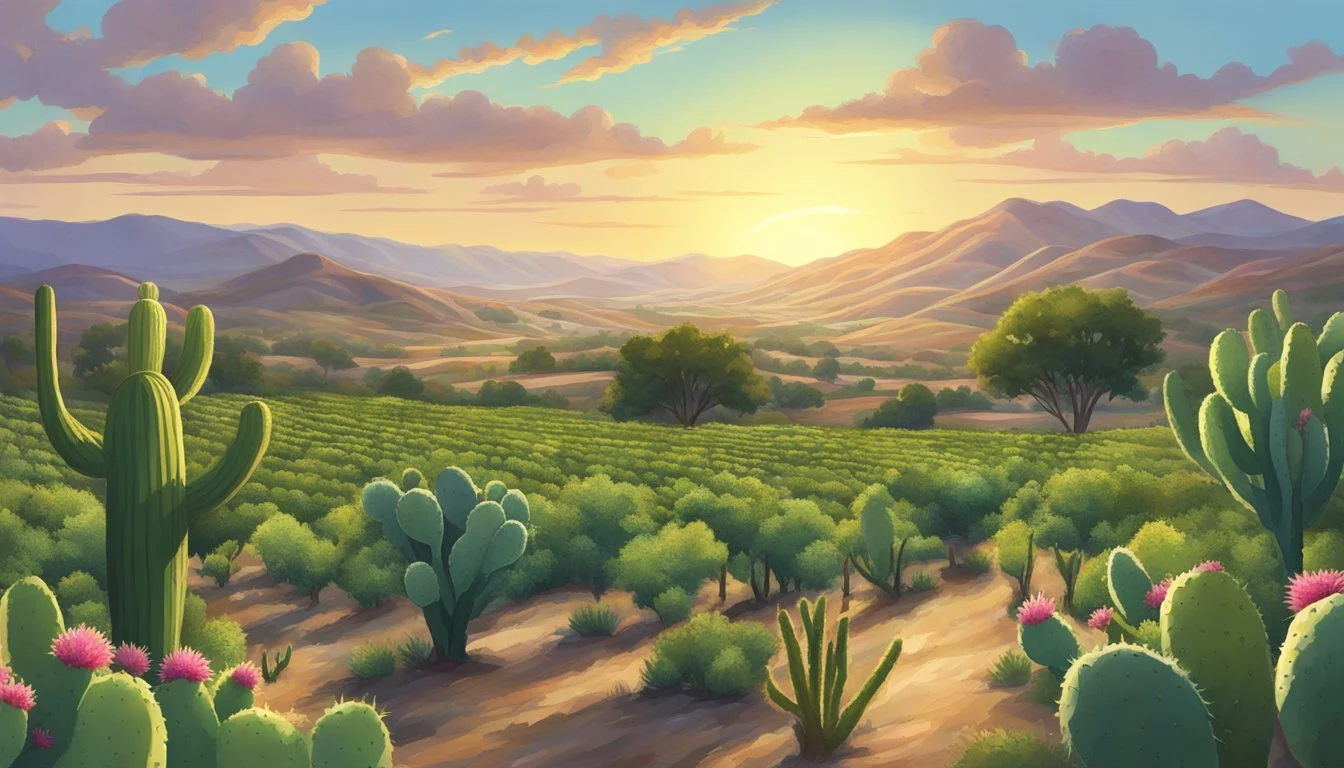Central Valley Native Edible Plants
A Guide to Sustainable Foraging
California's Central Valley is home to a rich tapestry of native plants that are not only beautiful but also edible. The indigenous peoples of the region have long utilized these plants for their nutritional and medicinal properties, integrating them into their daily lives. From the acorns of the California Black Oak, which were a dietary staple, to the vibrant berries of the Thimbleberry, these plants offer a direct connection to the natural history and cultural heritage of the area.
The Pacific Northwest's Bigleaf Maple can also be found in the Central Valley, providing edible flowers and sap that can be cooked into syrup. Another notable mention includes the tubers of the Nahavita, known for their purple flowers and edible corms, which have been a staple for the Owens Valley Paiutes.
Exploring and foraging the variety of edible native plants in California's Central Valley provides not only a gastronomic adventure but also a deeper appreciation for the region's native biodiversity and the sustainable practices of its indigenous communities.
Historical Importance
The Central Valley of California has a rich history of using native edible plants, especially among Native American communities. Their foraging practices not only provided sustenance but also shaped the cultural and daily life of these indigenous populations.
Native Americans and Edible Plants
Native Americans in the Central Valley, such as the Yokut and Miwok tribes, relied heavily on native plants for their diet. Acorns were a staple, collected and ground into flour using mortar and pestle.
They also consumed tubers, berries, nuts, and seeds from plants like the nahavita and lemonade berry. These foraged foods were not only dietary staples but also used in medicinal practices and spiritual ceremonies. The deep knowledge of plant life passed through generations ensured sustainable harvesting practices.
Evolution of Foraging Practices
Over time, foraging practices evolved in response to environmental changes and interactions with other cultures. Ancient irrigation techniques, notably by the Owens Valley Paiutes, enhanced the growth of tuberous plants.
Techniques for harvesting and preparing food became more refined, facilitating a balanced use of resources. The adaptation of foraging methods allowed Native Americans to thrive in varying climates and landscapes of the Central Valley, ensuring the preservation of critical plant species used for food, medicine, and tools. Detailed understanding and innovations in these practices highlight the ingenuity and resilience of these communities.
Ecological Impact
Native edible plants in California's Central Valley play a critical role in maintaining wildlife habitats and promoting biodiversity. These plants sustain various species and support agricultural practices by offering alternative food sources and enhancing ecosystem stability.
Native Plants and Wildlife
Native plants provide essential sustenance for numerous wildlife species. Birds, for example, rely heavily on the seeds and fruits from these plants. Many butterflies depend on specific native host plants for their larvae, facilitating successful breeding cycles.
Various insects, including bees, benefit significantly from native plants as they offer abundant nectar sources. This supports pollination, crucial for ecosystem health and stability.
In turn, healthy wildlife populations contribute to seed dispersal and pollination, creating a symbiotic relationship that strengthens the ecosystem.
Biodiversity and Native Crops
Native plants enhance biodiversity in California's Central Valley by preventing monoculture dominance. This diversity is vital to sustaining a healthy ecological balance, protecting against pests and diseases that often afflict non-native crops.
The incorporation of native plants into agricultural practices helps maintain soil health. Native species have deep root systems that prevent soil erosion and improve water retention, benefiting crop yield and quality.
Additionally, native crops can serve as a resilient alternative food source. They are adapted to the local climate and soil, requiring fewer resources such as water and fertilizers, which aligns with sustainable agricultural practices in the Central Valley.
Nutritional Profiles
Central Valley's native edible plants boast a variety of nutritional benefits. These plants are rich in essential nutrients, proteins, and vitamins that contribute to a healthy diet.
Nuts and Seeds
Nuts and seeds native to the Central Valley, such as acorns and chia seeds, are nutritional powerhouses. Acorns are high in carbohydrates and provide a good energy source. They are also rich in dietary fiber, essential for healthy digestion. Chia seeds contain high levels of omega-3 fatty acids, which are crucial for heart health. They are also a good source of protein and various minerals, including calcium and magnesium. Consuming these nuts and seeds can significantly contribute to a well-balanced diet by offering essential nutrients.
Fruits and Berries
Native fruits and berries, like the Rubus ursinus (California blackberry), elderberries, and prickly pear, provide essential vitamins and minerals. California blackberries are rich in vitamin C, fiber, and antioxidants, which help in maintaining a robust immune system. Elderberries are another great source of vitamin C and antioxidants, supporting immune defenses and reducing inflammation. Prickly pears contain high levels of vitamin C, magnesium, and dietary fiber. They also provide betalains, which have anti-inflammatory and antioxidant properties. These fruits and berries play a crucial role in enhancing overall health with their nutrient-dense profiles.
Vegetables and Herbs
Among the native vegetables and herbs, Allium species such as wild onions, and lamb's quarters stand out for their nutritional content. Wild onions are low in calories yet provide significant amounts of vitamins A and C, promoting good vision and skin health. They are also rich in quercetin, a powerful antioxidant. Lamb’s quarters offer high levels of vitamins A, C, and K, along with minerals like iron and calcium. This green leafy vegetable supports bone health and boosts immunity. Including these vegetables and herbs in the diet adds essential nutrients and flavors, contributing to overall well-being.
Cultivation
Cultivating native edible plants in California's Central Valley involves careful planning and the usage of traditional agricultural techniques. These practices ensure that plants thrive in their natural habitat while providing edible yield.
Edible Garden Planning
First, identifying suitable native plants is crucial. Species such as Bigleaf maple (Acer macrophyllum), Wild onions (Allium spp.), and Big saltbush (Atriplex lentiformis) offer both ecological and culinary benefits.
Next, garden layout is essential. Arrange plants based on their sunlight, water, and soil preferences, ensuring each species gets the conditions it needs. A well-planned garden might include:
Sunny spots for saltbush and alliums.
Shaded areas for Thimbleberry and similar plants.
Consider seasonal changes and plant succession to maintain continuous harvests throughout the year. Use mulch and organic matter to enhance soil fertility and retain moisture.
Traditional Agricultural Techniques
Traditional techniques enrich the soil and support plant health. Practices like crop rotation prevent nutrient depletion and pest buildup. Companion planting, where compatible plants grow together, can deter pests and promote growth.
Irrigation methods matching natural rainfall patterns help conserve water. Techniques such as:
Drip irrigation for efficient water use.
Rain gardens to capture runoff.
Maintaining biodiversity by including various native species helps create a balanced ecosystem. Indigenous knowledge suggests that integrating plants like Red maids (Calandrinia menziesii) can enhance the garden's resilience and productivity.
Overall, these strategies support sustainable agriculture and promote the successful cultivation of native edible plants in Central Valley gardens.
Regional Varieties
Exploring the diverse native edible plants that thrive across the Central Valley unveils a rich mosaic of species adapted to distinct sub-regions. Each area, from Southern California to the Channel Islands, contributes unique flora influenced by climate and geography.
Plants of Southern California
Southern California boasts a variety of native edible plants well-suited to its Mediterranean climate. Acer macrophyllum, or Bigleaf maple, features notable flowers that can be consumed raw or cooked, and its sap is harvested for syrup. The region's Allium spp. (wild onions) are popular for their flavorful bulbs. Bladderpod (Peritoma arborea), identified by its inflated fruits, is another edible, providing a fresh, mustard-like relish.
Plants of the Sierra Range
The Sierra Range is home to species like Nahavita (Dichelostemma capitatum), a plant cherished for its edible corms under its purple, attractive flowers. Native Americans, such as the Paiutes, historically cultivated this plant. High-altitude flora also includes the thimbleberry (Rubus parviflorus), whose fruits are reminiscent of raspberries—perfect for foraging enthusiasts seeking a native berry.
Channel Islands Flora
The unique environment of the Channel Islands supports species not commonly found on the mainland. Island cherry (Prunus ilicifolia) produces small, edible cherries that were a staple for indigenous peoples. Island mallow (Malva assurgentiflora), with its vibrant flowers, offers young leaves and shoots suitable for salads. Importantly, these plants often show greater salt and drought tolerance, adapting to the island’s coastal conditions.
Northern Baja California Species
Northern Baja California's arid climate hosts resilient edible plants like the desert agave (Agave deserti), whose hearts can be roasted for food. Ferocactus spp. (barrel cacti) offer edible fruits and seeds. Additionally, the Opuntia spp. (prickly pear) cacti provide edible pads, or "nopales," and sweet, nutrient-rich fruits, creating a versatile ingredient in traditional cuisines.
These plants enrich local biodiversity and are integral to the ecosystem, providing food resources to both humans and wildlife.
Safety and Sustainability
When foraging for edible plants in California's Central Valley, understanding safety and sustainable practices is crucial. Careful attention to guidelines and awareness of toxic plants ensures a beneficial and secure foraging experience.
Foraging Guidelines
Foragers should follow certain guidelines to protect both themselves and the environment. Only collect plants from areas where foraging is permitted to avoid legal consequences and respect local ecosystems. Ensure identification is accurate by using reliable resources or consulting with experts.
Avoid overharvesting to maintain plant populations and their habitats. Take only what is needed, and never harvest more than 10% of any given plant population. Bring proper tools and containers to minimize damage to plants and their surroundings.
By adhering to these guidelines, foragers can enjoy the benefits of edible native plants while fostering a sustainable practice that preserves the natural balance of the Central Valley.
Avoiding Toxic Plants
Recognizing and avoiding toxic plants is essential for a safe foraging experience. Some plants in the Central Valley resemble edible varieties but can be harmful if consumed. Always double-check plant identification against multiple sources and, when in doubt, refrain from eating the plant.
Common toxic plants to avoid include poison hemlock (Conium maculatum), which can be confused with wild carrot, and jimsonweed (Datura stramonium), known for its toxic alkaloids. Learning to identify these plants, including their look-alikes, is critical for ensuring safety.
Awareness and education about toxic plants protect foragers from accidental ingestion, making their foraging adventures both safe and enjoyable.
Plant Guides
This section explores various native edible plants found in the Central Valley, focusing on distinct categories such as cacti, berries, herbs, and larger woody plants like trees and shrubs.
Prickly Pear Cactus
Prickly Pear Cactus (Opuntia spp.) is a versatile native plant known for its edible pads and fruits. The pads, known as nopales, are harvested while young and tender. They can be grilled or boiled and are popular in salads and dishes for their crunchy texture and slightly tart flavor.
The fruits, called tunas, become ripe in late summer and have a sweet, juicy taste. Important: Handle with care due to the plant's spines, using gloves and tools to avoid injury. Their nutritional value includes high levels of vitamin C, antioxidants, and dietary fiber.
Berry Plants
Berry plants like the California Blackberry (Rubus ursinus) and the Hollyleaf Cherry (Prunus ilicifolia) thrive well in the Central Valley. California Blackberry produces small, sweet-tart berries that are rich in vitamins and antioxidants.
Hollyleaf Cherry fruits are small, dark cherries that offer a sweet taste when ripe. They are often eaten fresh or used to make jams and jellies. Another notable berry, though less common in this region, is the Blueberry (Vaccinium spp.). While not a typical native, certain cultivars can adapt to local conditions and yield nutritious berries.
Herbaceous Species
Herbaceous species like the Wild Onion (Allium spp.) are significant due to their culinary uses and ease of cultivation. Wild Onions have slender, cylindrical leaves and clusters of small, edible bulbs that impart a mild, onion-like flavor, making them suitable for various dishes.
Other notable herbaceous species include plants like Miner’s Lettuce (Claytonia perfoliata), which is favored for its fresh, succulent leaves that are high in vitamins A and C. These green leaves are often used in salads and bring a slight, tangy taste that enhances dishes.
Tree and Shrub Plants
Tree and shrub plants such as the Bigleaf Maple (Acer macrophyllum) and Grape (Vitis spp.) provide valuable edibles. Bigleaf Maple is known for its sap, which can be cooked down to make syrup. The young flowers can also be consumed either raw or cooked.
Grape vines, which are characteristic of the region, produce sweet fruits that can be eaten fresh, dried as raisins, or fermented into wine. These plants are not only key for their fruits but also for their ecological benefits, contributing to soil stability and local biodiversity.
Utilizing these native edible plants can support sustainable gardening practices, provide nutritious food sources, and help maintain the biodiversity of the Central Valley region.
Garden Design
When designing a garden with Central Valley native edible plants, focus on integrating edible natives and selecting suitable groundcovers and perennials to create a sustainable, productive, and aesthetically pleasing space.
Incorporating Edible Natives
Edible native plants bring both ecological and culinary benefits. Species like the Valley Bladderpod (Peritoma arborea var. globosa), with its distinctive spherical fruits, can be a valuable addition. Thimbleberry serves as a great substitute for non-native berries, offering both fruit and ornamental appeal.
Bigleaf Maple (Acer macrophyllum) is another excellent choice. Its flowers can be consumed raw or cooked, and its sap is a source of syrup. Wild Onions (Allium spp.) thrive in many garden environments, contributing both flavor and resilience to semi-wild spaces.
Proper placement considers sunlight, moisture, and soil conditions to mimic natural habitats. For instance, American cranberry needs consistently moist, acidic soil and cooler climates for optimal growth.
Groundcovers and Perennials
Integrating low-growing groundcovers and hardy perennials helps maintain soil health and reduce maintenance demands. Options like Yerba Buena (Clinopodium douglasii), a fragrant herb, provides excellent ground cover while being useful in teas and cooking. California Fuchsia (Epilobium canum) can serve a dual role as both a vibrant perennial and a pollinator attractor.
Western Yarrow (Achillea millefolium) is another effective groundcover, known for its robust growth and medicinal properties. It stabilizes soil and requires minimal water once established.
Using perennials such as Soap Plant (Chlorogalum pomeridianum), which has edible bulbs and fibrous leaves, offers longevity and annual productivity. These plants support soil stability, biodiversity, and provide year-round harvests.
Strategic implementation of these plants ensures a thriving, diverse garden space that maximizes both ecological and edible outputs.
Conservation and Ethics
Conserving native edible plants in California's Central Valley involves responsible cultivation practices and respecting the traditional knowledge of Native Americans. These efforts help maintain biodiversity and honor cultural heritage.
Responsible Cultivation
Responsible cultivation of native edible plants requires careful planning and sustainable practices. Enthusiasts should begin with species that thrive in the area, such as bladderpod and thimbleberry. Avoid overharvesting to ensure these plants continue to flourish.
It's essential to consider the impact on local ecosystems. For instance, many native plants support pollinators like bees and butterflies. Proper cultivation respects this interdependency, fostering a balanced environment.
In addition, gardeners should use organic methods to avoid introducing harmful chemicals. Rotating crops and natural pest control can further contribute to a healthy habitat.
Preserving Native Traditions
Native Americans have long relied on plants like nahavita (Dichelostemma capitatum) for sustenance. Understanding and preserving these traditions is crucial. This includes not only the knowledge of which plants are edible but also traditional harvesting and preparation methods.
Efforts to engage with Native communities and learn from their heritage can guide modern conservation. It’s important to respect their rights and involve them in decision-making processes concerning native plant management. This collaboration can lead to the revival and continuation of important cultural practices while also supporting conservation goals.
Such respect and collaboration can ensure that both ecological and cultural aspects of native plants are preserved for future generations.
Usage and Recipes
Central Valley native edible plants have been utilized for centuries, both traditionally and in modern cooking. The rich diversity of plants offers a variety of flavors and nutritional benefits.
Traditional Uses
Indigenous peoples of the Central Valley have a long history of using native plants in their diets. Acorn was a vital staple, often processed into flour for bread and porridge. They employed intricate leaching techniques to remove bitter tannins.
Chia seeds were another important food source, ground into flour or mixed with water for a hydrating drink. Prickly pear cactus offered sweet fruit and nutritious pads which were eaten raw, boiled, or roasted.
These plants were essential not just for nutrition, but also for their medicinal and ceremonial roles, reflecting a deep connection to the land.
Modern Culinary Applications
Today, Central Valley native plants continue to inspire chefs and home cooks. Acorn flour can be used in baking, adding a unique flavor to bread, pancakes, and cookies. It is also a gluten-free alternative.
Chia seeds are popular in smoothies, puddings, and as egg substitutes in vegan recipes. Prickly pear fruit is utilized in jams, jellies, and cocktails, while the pads, known as nopales, feature in salads, tacos, and as a grilled side dish.
These plants not only enhance the variety of ingredients but also promote sustainable and local eating practices that honor traditional foodways.










